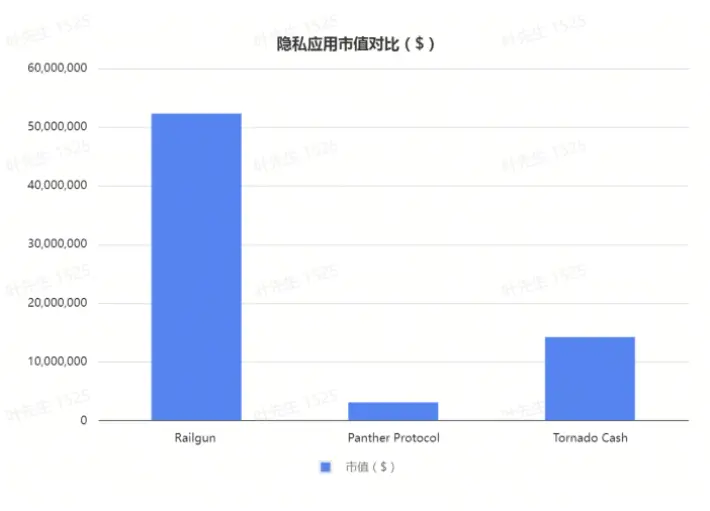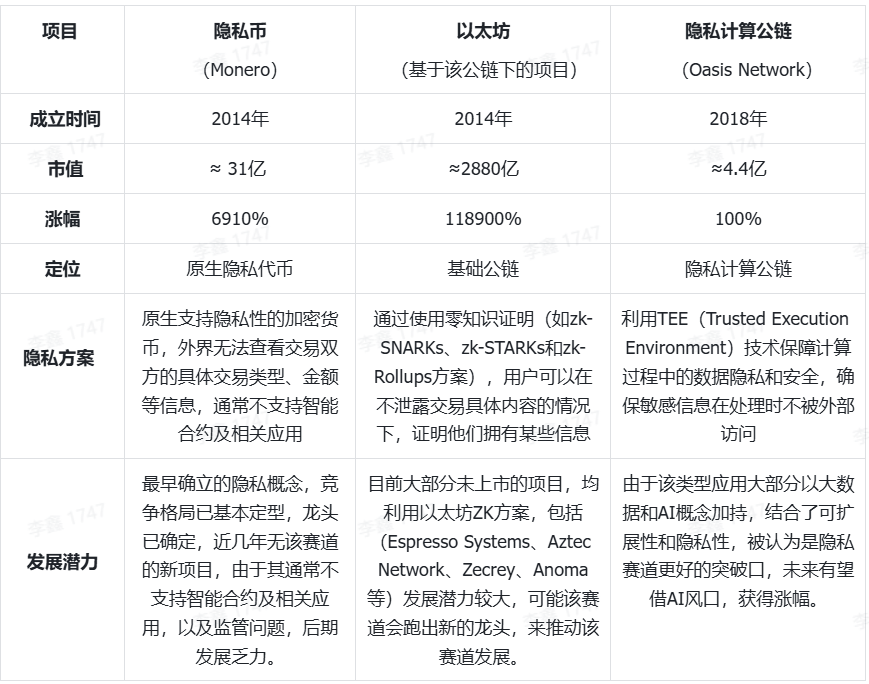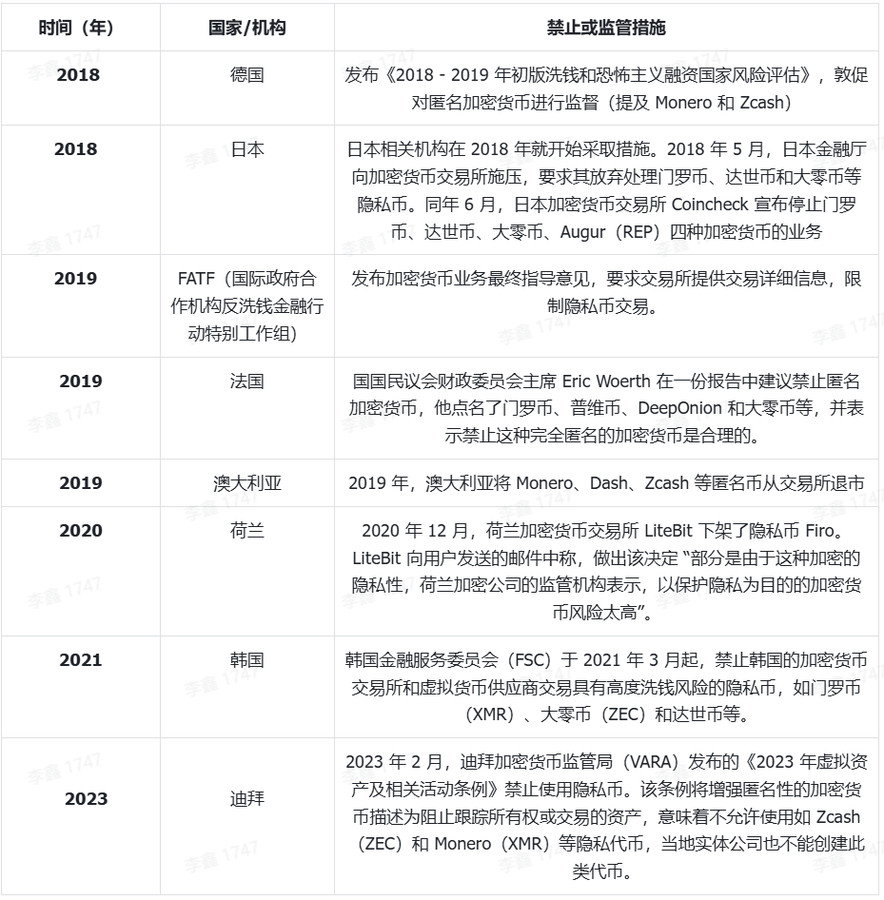A panoramic analysis of the privacy track: defending privacy or fostering crime, the revolution has not yet succeeded
Author: Ice Frog
Introduction:
On September 19, Coinbase launched the programmable privacy network Aleo. It is not surprising that a star project backed by top investment institutions is listed on a leading exchange. However, considering that Aleo is situated in the privacy sector, which has long faced regulatory pressure, this seemingly ordinary token launch becomes quite extraordinary.
Especially given that Coinbase is the most compliant exchange globally, it is worth exploring how the industry is developing in today's increasingly niche privacy sector, including crises and opportunities, and prospects. This article will detail each aspect.
I. Industry Overview: Niche Market, Continuous Progress, but Limited Development
1.1 Development Overview
If the core of the blockchain world lies in decentralization, then privacy protection and security are rigid application scenarios that extend from this core, embodying the original spirit of cryptocurrency. Naturally, this has become an important branch and direction of Web3 development.
The earliest cryptocurrency, Bitcoin, was partly designed to achieve anonymity. Users are distinguished by a string of alphanumeric characters known as public keys to ensure their privacy. However, with the development of blockchain and the continuous rise of applications like DeFi, the demand for asset security far exceeds the demand for privacy. Additionally, the emergence of on-chain analysis tools has gradually weakened the privacy characteristics of blockchain.
Nevertheless, compared to the privacy issues of Web2, blockchain technology in Web3 remains an important means of addressing privacy protection, especially as the Web3 world becomes increasingly mainstream. Privacy protection is not only a significant issue in the crypto world but also one of the keys to expanding the user base.
The privacy aspect of the blockchain world mainly addresses the privacy protection issues arising from the public and transparent nature of blockchain. However, in the early stages of development, some crypto fundamentalists directly launched native privacy coins. The extreme anonymity and privacy protection features of privacy coins have become a model for protecting user privacy, but they have also become a breeding ground for illegal activities such as money laundering, funding terrorism, tax evasion, and drug trafficking.
Thus, amid the ongoing controversy between "privacy guardians" and "criminal havens," regulatory crackdowns continue. However, both investment institutions and users still express ongoing interest and investment in the privacy sector. Although the sector is becoming increasingly niche, technological progress has never ceased.
1.2 Definition, Characteristics, and Technology of Sub-sectors
The privacy sector can be roughly divided into four major segments: privacy coins, privacy trading networks, privacy computing networks, and privacy applications. The main characteristics of these sub-sectors are summarized in the table below:

From the above sub-sectors, it can be seen that there are corresponding solutions and projects for privacy in native crypto tokens, data computation, transaction processes, and specific privacy needs. However, in terms of development, the overall scale and progress are not satisfactory.
From a technical perspective, privacy coins are mainly composed of technologies such as ring signatures, stealth addresses, and environmentally friendly transactions. After years of development, the technology has matured relatively, and the technical development threshold is relatively low.
Privacy public chains mainly rely on zero-knowledge proofs (ZK), trusted execution environments (TEE), secure multi-party computation (MPC), and homomorphic encryption (HE). ZK technology is essentially a data obfuscation tool, while the latter three are encryption data processing technologies. In terms of technological maturity and difficulty, all four technologies are significantly more advanced than those of privacy coins, with TEE technology being relatively mature, MPC technology being widely used in custody and wallets, and homomorphic encryption being one of the technologies favored by institutions after ZK.
II. Analysis of Mainstream Projects in the Sector: Privacy Coins Dominate, Privacy Protocols are Rising
2.1 Privacy Coin Sector
The pioneer of the privacy sector, launched in 2014, refers to cryptocurrencies that natively support privacy, enabling completely private transactions where external parties cannot view the specific transaction types, amounts, and other information between the parties involved. The downside is that they typically do not support smart contract functionality and related applications.
Listed token projects:
Monero (XMR)
- The privacy sector's ancestor, Monero, hides the addresses used by participants, allowing transaction details (such as the identities of senders and receivers, as well as the amounts of each transaction) to remain private.

- Launched in 2014, after nearly ten years of development, its market cap has grown from about $1.41 million at launch to a current FDV of $3.1 billion, an increase of approximately 2200 times, making it the leading project in this sector.
Zcash (ZEC)
- ZEC is a cryptocurrency with privacy protection features, also known as "Zerocoin." It uses zero-knowledge proof technology to achieve anonymous transmission. The protocol provides a shielding option for transactions, allowing for complete anonymity when enabled.

- Its token was issued in October 2016, with a market cap growing from an early $2.09 million to about $500 million today, an increase of approximately 240 times, but it has dropped 90% from its peak.
Dash (DASH)
- Dash (originally CoinJoin), known as "DASH" in Chinese, enhances the anonymity of transactions through its unique mixing mechanism.

- This project was also launched in 2014, with a market cap of about $1.1 million at launch, and currently stands at about $290 million, an increase of approximately 264 times, but it has dropped over 90% from its peak market cap.
The above three projects are currently the top three in the privacy coin sector. Privacy coins were an early attempt to add privacy attributes to cryptocurrencies. Although they have all seen significant increases since their launch, they have all dropped significantly from their peaks, making it difficult to return to those heights.

Overall, the privacy coin sector has shown an upward trend since its launch. In January 2021, privacy coins accounted for 96.6% of the sector's dominant share (with a market cap of about $4.62 billion).
With the subsequent launch of privacy-related protocols, this share dropped to 72.76% (with a market cap of about $3.6 billion) by September 2024.
In contrast, the market share of privacy protocols grew from 3.4% (with a market cap of about $16 million) in January 2021 to 27.24% (with a market cap of about $134.8 million) by September 2024. Currently, privacy coins still dominate the sector, primarily due to Monero holding a significant portion of the market.
2.2 Privacy Trading Networks
The underlying architecture supports privacy smart contracts on basic public chains, primarily targeting the privatization of on-chain transaction data. Through technologies like ZK, it natively supports users in conducting privacy transactions, protecting their transaction privacy during the trading process by hiding transaction data (transaction parties, time, asset transfer amounts, etc.), while also supporting the development of more types of privacy applications within the protocol.
Regarding the privacy issues of smart contracts, one type focuses on the infrastructure based on public chains to solve the privacy issues of public chains; the other focuses on privacy computing, aiming to develop vertical niche fields.
Privacy public chains include Layer 1 privacy protocols and Layer 2 privacy protocols. The former includes Aleo, Iron Fish, Horizen, Anoma Network, Concordium, and Espresso Systems, while the latter includes Manta Network, Aztec Network, and Zecrey.
Layer 1 Listed Projects:

The above are some of the listed projects in this sector, which were launched around 2017 after the boom of privacy coins. Compared to early privacy coins, the technology has been updated, incorporating the concept of privacy smart contracts. However, in terms of market cap and attention, these projects are several magnitudes smaller than privacy coins. Except for the earliest launched Horizen, the other projects have been in a downward trend, and even the Super Zero project has ceased operations, showing overall poor performance.
Notably, the only project that has seen an increase, Horizen, announced in June 2023 that it would remove its privacy features, reportedly to alleviate regulatory pressure.
Overall, early Layer 1 projects have not gained market recognition, and combined with regulatory pressure, they have failed to form a substantial presence in the market.
Layer 1 Upcoming Projects:

Compared to early listed Layer 1 privacy protocols, the subsequent unlisted projects show higher potential, especially with the participation of top investment institutions providing substantial funding to support ongoing development and operations. However, a common drawback is the generally long development cycle.
Currently, Aleo has announced its launch on Coinbase, and Anoma is also about to issue tokens, with no participation opportunities available, leaving only Espresso Systems, which has released five testnets and can be monitored for timely participation.
Aleo, which has received an extraordinary $200 million in Series B funding, has top-tier investment institutions backing it, including A16Z, SoftBank, Polychain, Tiger Global, Samsung, and others. Notably, Coinbase also participated in the investment, which may be one reason Aleo was able to launch on the Coinbase exchange.
Layer 2 Privacy Projects:
These are additional layers built on existing Layer 1 blockchain architectures. They do not directly alter the underlying infrastructure but implement privacy protection features through technologies like smart contracts, sidechains, and state channels.

From the above projects, it is evident that although the investment institutions involved are all top-tier, the listed projects have not generated market enthusiasm.
Manta Network has seen its value drop by about half since its listing;
The Aztec Network project has been in development since 2018 and is still in the developer testing phase, with slow progress.
Zecrey was also established in 2021 and launched its testnet in 2022. It is still in the testing phase.
2.3 Privacy Computing Networks:
These are foundational public chains that support privacy smart contracts, but their native tokens are not privacy coins. This concept emerged in 2018, and that year saw a surge of projects focused on privacy computing. These projects are not limited to on-chain data privacy protection; they address privacy issues in the data computation phase and are generally referred to as privacy computing public chains. Representative projects include Oasis Network, Secret Network, ARPA, and PlatON.

In terms of overall market cap, this sub-sector has seen limited growth over the years, with a total market cap of less than $500 million, making it small and accounting for only about 10% of the entire privacy sector.
The main development bottleneck for privacy computing is the lack of blockbuster applications. There are only a few use cases in enterprise-level applications, and there are significant challenges in specific technical practices. However, privacy computing has a natural connection with current AI and big data. As AI applications have not yet deeply addressed privacy pain points, it is expected that with the development of AI, projects focusing on AI privacy computing may experience a new round of growth.
2.4 Privacy Applications
Privacy applications are software programs designed directly for user needs, with the core goal of providing privacy services to users in specific usage scenarios. Essentially, they start from user experience and specific business needs, integrating various privacy protection technologies to meet users' confidentiality requirements for certain types of information.
Examples include mixing applications and encrypted emails, with representative projects such as Railgun, Tornado Cash, Panther Protocol, and Onion Mixer.

The user base for privacy applications is relatively small, and some projects have ceased operations for various reasons, primarily because the demand for privacy applications is often not a core need for ordinary users. Representative mixing applications are mostly used for illegal purposes.
Railgun: The FBI has stated that North Korean hacker groups used the Railgun privacy protocol to launder over $60 million worth of Ethereum stolen from the Harmony Horizon Bridge.
Tornado Cash: Since its creation in 2019, it has been designated by the U.S. Treasury as a money laundering tool, allegedly laundering over $7 billion worth of virtual currency. In August 2022, the U.S. Treasury placed some Ethereum addresses that interacted with the Tornado Cash protocol or were related to it on the Specially Designated Nationals list, freezing the assets and property rights of individuals or related entities.
Considering various factors, this sub-sector is not a mainstream demand, is often linked to black and gray markets, and has a relatively low market cap within the entire privacy sector.
III. Risks and Opportunities in the Privacy Sector: Rigid Demand vs. Regulatory Pressure
Undoubtedly, the privacy sector remains niche in the current blockchain world, with an overall market cap of about $5-6 billion, half of which is accounted for by Monero alone. This relatively niche sector, however, has attracted significant investment and attention from many top investment institutions, which is intriguing. It at least indicates that investment institutions see high growth potential for the privacy sector.
Regulatory crackdowns are not primarily about privacy issues themselves but rather about how privacy tools facilitate crime. Privacy coins emerged during the early chaotic era, providing users with sufficient anonymity and untraceability in transactions, gaining favor among some geeks and crypto fundamentalists, as they genuinely addressed users' privacy pain points. However, this has also led to money laundering, dark web crimes, extortion, and other illegal activities.
A token does not possess criminal attributes, but it indeed opens the door to crime, making regulatory scrutiny inevitable. The table below reveals the privacy coins that have been delisted in recent years due to compliance and other reasons, along with various countries' regulatory requirements.
- Exchanges delisting privacy coins:

- Countries banning privacy coins:
In addition to the aforementioned exchange delistings and country bans, privacy coins are also essential tools for hackers.
Monero is often used for browser hijacking mining and extortion payments (In 2020, the ransomware gang Revil attacked the American wine and spirits giant Brown-Forman Corp, demanding ransom payments in Monero).
North Korean hackers used Tornado Cash for money laundering (they allegedly used Tornado to clean stolen funds, and the platform has been accused of facilitating over $1 billion in money laundering transactions).
Setting aside regulatory aspects, from the perspective of genuine user demand, the transparency and privacy of blockchain are inherently oppositional. From a certain angle, they should jointly form a part of the blockchain's impossible triangle along with security.
As blockchain has developed, especially with the introduction of smart contracts, broader applications have also brought about more severe data breaches and subsequent hacker attacks, such as sandwich attacks and vulnerability exploits. The resolution of these issues also relies on the continuous innovation of privacy technologies and projects. More importantly, as the wealth effect of blockchain increases, whale users are very susceptible to targeted hacker attacks or phishing, making privacy an important and urgent demand.
However, from the perspective of sector development, there are currently over a hundred projects in the privacy sector. Aside from the high technical barriers and long development cycles, few can meet regulatory requirements at the protocol level, with most giving data disclosure rights to users.
For the privacy trading network sector, balancing compliance and privacy is the first hurdle to overcome. If an effective solution can be formed, there is still an opportunity to enter the public market and seize development opportunities.
Taking Aleo as an example, it uses ZK technology to hide transaction details by default, but allows users to selectively disclose them when necessary. Additionally, the project team has embedded compliance checks into the smart contracts to ensure overall compliance with regulatory requirements.
Furthermore, from a technical perspective, the two most notable technologies in the privacy sector currently are zero-knowledge proofs and homomorphic encryption technology:
Zero-knowledge proofs: Widely used in the Ethereum ecosystem, so there is no need to elaborate further.
Homomorphic encryption technology: It has better application scenarios in privacy computing, but in horizontal comparison, there has not been a significant explosion. It not only lags far behind public chains like Ethereum but has not yet reached the scale of early privacy coins. However, as the privacy computing public chain sector most closely related to AI, it is expected to benefit from the continuous development of AI.
Comparison of the current status of various sectors:

IV. Outlook and Summary: Balancing Privacy and Compliance, Potential is Promising
Privacy, as one of humanity's oldest needs, has not been fully recognized in either Web2 or Web3, especially as the value of data itself has not become a strong consensus. This directly leads to a lack of strong willingness and motivation at the user level.
An undeniable reality is that, on one hand, with the improvement of on-chain tools, user assets and interactions are fully exposed, but at the same time, we are also deceived by deliberately concealed address identities. These two aspects are both contradictory opposites, and both are pain points that need to be addressed.
Since 2013, to address Bitcoin's insufficient privacy, "mixing" technology emerged. However, it only increased the difficulty of tracking and did not achieve true anonymity, relying on third-party participation and having insufficient anonymity. Subsequently, privacy coins represented by Monero and Zcash emerged, utilizing advanced zero-knowledge proof and ring signature technologies to provide strong encryption privacy protection for native coins. Meanwhile, layer two solutions such as sidechains and channels have also been proposed, but they are mostly limited to transaction anonymity and are difficult to apply in the smart contract field.
Starting in 2018, privacy computing projects emerged, most of which integrated big data and AI concepts, aiming to achieve both scalability and privacy enhancement, seen as a new breakthrough in the privacy sector. However, despite years of development, the overall ecosystem of privacy computing public chains remains small, with low market caps (only accounting for about 10% of the entire sector). As of September 16, 2024, the total market cap of the entire privacy sector is approximately 5 billion USD, which appears relatively niche compared to other crypto ecosystems.
From past developments, the privacy sector, as a fundamental need of blockchain, faces challenges not only in collective user cognition but also in technological development issues, along with ongoing regulatory risks. This somewhat limits its vigorous development and imposes high demands on projects, further hindering broader adoption.
From the data perspective, from 2021 to 2024, the overall market share has declined. Due to the influence of black and gray markets, privacy coins are expected to struggle to return to their peaks in the short term. Privacy protocols and applications, limited by their practicality and value, are not ultimate solutions. The much-anticipated privacy computing public chains have shown lackluster performance after years of cultivation. However, with the booming application of AI, this sub-sector may see an explosive growth opportunity. Additionally, the ZK privacy (privacy trading network) concepts centered around Ethereum are worth attention, as this field gathers many star projects and has received substantial institutional funding support, with many still in development stages and not yet fully implemented. When market conditions improve, there may be good opportunities and value for participation.
On the basis of balancing compliance and privacy, the privacy sector still holds great promise. This is not only due to the optimism and backing of top institutions but also because, from a long-term perspective, it addresses the security of the most critical asset in the future world—data assets. This not only has long-term value but also easily forms high barriers from a business model perspective, thereby occupying a favorable position. From this angle, the privacy sector is not limited to "money laundering." As the blockchain world matures and becomes mainstream, its potential space remains worth looking forward to, truly becoming the guardian of user privacy.










